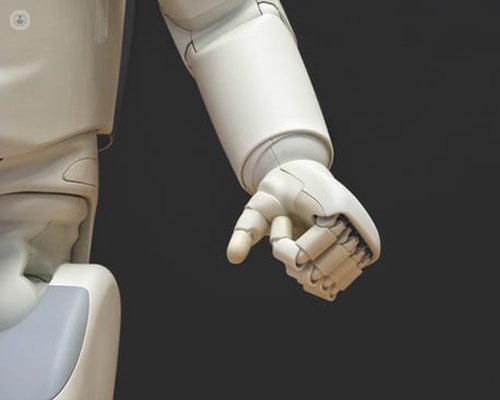All you need to know about robotic prostatectomy
Escrito por:Mr Philip Charlesworth is a renowned urologist in the London & Berkshire area who is one of the leaders in the field with his dedication to prostate cancer and radical prostatectomy. He explains this effort and the importance of the newer technology he is using to save lives.

Why robotic prostatectomy?
Surgical removal of the prostate for cancer, radical prostatectomy (removing the whole prostate) remains one of the gold standard treatments of choice for men with clinically significant localised prostate cancer. Technically, radical prostatectomy is a very challenging operation, in part due to the fact that structures important for urinary continence and sexual function are in close proximity to the prostate, and the cancer within it.
Radical prostatectomy was traditionally performed using an open surgical technique. Over the years this has transitioned to keyhole laparoscopic techniques, and then into keyhole robotic approaches. Using Da Vinci robotic system to perform Radical Prostatectomy is one of the major advances in prostate cancer surgery made over recent years. Thanks to technological developments in robotic surgical systems, Mr Philip Charlesworth offers robot-assisted radical prostatectomy using Da Vinci Surgical System, which enables a safer, more precise and minimally invasive removal of a cancerous prostate gland.
By incorporating sophisticated wristed technology, Da Vinci robotic system offers surgeons the ability to operate, dissect, and suture with the facility of a human wrist. The robotic system offers an unprecedented view of the operative field and periprostatic anatomy due to the 10x magnified, 3D High-Definition image. Mr Philip Charlesworth has access to the latest Da Vinci surgical systems (Xi) to perform his operations
A robotic prostatectomy using the Da Vinci Surgical System is a minimally invasive keyhole surgery carried out by a specially trained surgeon. It was shown in several studies around the world that surgeon experience is one of the most important factors in achieving the best oncological, functional, and sexual outcomes following robotic prostatectomy. Mr Philip Charlersworth has performed over 700 complex robotic operations over the past five years.
Further development of robotic techniques and experience has led to latest technique of Retzius-sparing prostatectomy. This allows unique preservation of the urinary continence mechanisms, and has been proven to drastically improve early and full return of urinary continence. This is still only offered by a handful of Surgeons within the UK, due to the increased complexity. Mr Philip Charlesworth from The Urology Partnership has been a pioneer of this technique since 2017, and is currently publishing his experience, which to date remains one of the largest series in the UK & North America.

The Da Vinci Robotic System and how it works
This sophisticated robotic system greatly extends the capabilities of the surgeons’ eyes and hands enabling for a more delicate and precise operation. The robotic system can achieve a far greater range of motion than the human hand and built-in tremor-filtration technology helps to move the instruments smoothly and accurately.
During surgery, the surgeon operates using the console positioned next to the patient. The surgeon can see the operative field and the prostate and periprostatic anatomy in a 3D HD view and control the console. The console diminishes any human hands tremor and precisely controls the four robotic arms and replicate the surgeon movements.
The first part of the surgery is to gain access to the abdomen. Access to the abdomen is granted by six small incisions, through which a trocar is inserted, which allows continuous access to the surgical field. The robotic arms are then attached to these trocars, through which the robotic instruments are introduced.
Next, the prostate and both vasa and seminal vesicles are exposed and detached from its surroundings, including the urinary bladder and rectum, taking care, if possible, to preserve the urinary sphincter and the neurovascular bundles responsible for erection. After removing the prostate, the continuity of the urinary system is achieved by suturing the bladder with the urethra over a catheter, kept in for several days.
The surgery typically lasts about two to three hours and is carried out under a general anaesthetic. At the end of the surgery, a surgical drain is kept in along with a urinary catheter. The drain will be removed the next day and patient discharged home with a catheter for four to seven days.
Prostate cancer and cancer control
Prostate cancer is the most common malignancy in males in the UK, with almost 50,000 new cases diagnosed every year. One in six UK males will be diagnosed with prostate cancer in their lifetime. Prostate cancer accounts for 13 per cent of all cancer deaths in males in the UK.
Directed with pre-operative MRI scans and targeted biopsies, robotic prostatectomy allows a very precise surgical removal of the prostate, which includes the removal of the entire cancerous gland, with a minimal chance of leaving any cancer behind (less than five per cent). The minimally invasive approach allows protection of all the important structures around the prostate that are responsible for urinary continence and sexual function. Using NeuroSAFE (intra-operative frozen section margin status) allows us to preserve the delicate nerves and vessels responsible for erections while minimizing the risk of exposing cancer cells at surgical margins.
Preserving continence
During a robotic prostatectomy, the surgeon can operate precisely within the tightly confined surgical area that is surrounded by nerves, muscles, and blood vessels critical for urinary continence and sexual function. This is particularly the case for Retzius-sparing robotic prostatectomy.
A major advantage of using the Da Vinci System is that surgeons have a far greater ability to spare these important surrounding structures. During surgery, the surgeon will preserve the muscle fibres and nerves that control continence.
Using these sparing techniques, patients are more likely to recover continence in a far shorter period following surgery.

Nerve sparing and sexual function
The nerves and blood vessels responsible for erections are paired and sit in very close proximity to the prostate gland. When possible, we will remove the prostate gland and make sure that the neurovascular bundles are intact, allowing erectile function recovery following the surgery.
What is NeuroSAFE?
In cases of more aggressive, larger tumours, the Urology Partnership also offer NeuroSAFE erectile nerve sparing. A technique that allows us to maximise nerve preservation without compromising cancer control.
Utilising NeuroSAFE as part of the prostatectomy, we can analyse the prostate gland immediately after it has been removed to establish if the cancer has spread outside of the prostate.
As soon as the prostate is removed, it is passed to a waiting pathologist where it is quickly frozen, cut into slices and examined under a microscope. The analysis is done rapidly and whilst the operation is still being performed. This gives the surgeon real-time information to help him decide between removing surrounding nerves (for better cancer control) or saving the nerves (for preserving sexual function).

Retzius-sparing Robotic Radical Prostatectomy
A more recent development in Robotic Radical Prostatectomy is the Retzius-sparing technique. Here, a surgeon approaches and removes the prostate in a different way than the standard approach. This approach preserves the anatomy of the urinary bladder and urethral sphincter, allowing faster recovery of urinary continence and possibly a better erectile function following the surgery.
Champions of this pioneering technique, Mr Philip Charlesworth routinely perform these complex operations entirely using the Da Vinci Robotic Surgical System. A large number of our patients have had no urinary incontinence at all following this surgical approach.
Several international publications utilizing this approach showed that almost 80 per cent of patients recovered their continence within a few days to a few weeks following surgery. 99 per cent of patients recovered their continence within six months. Overall, the post-operative quality of life of patients has been dramatically improved.
This recent development in robotic technique allows unique preservation of the urinary continence mechanisms, and drastically improves early and full return of urinary continence. This is still only offered by a handful of surgeons within the UK, due to the increased complexity. Mr Philip Charlesworth from The Urology Partnership has been a pioneer of this technique since 2017, and is currently publishing his experience, which to date remains the largest series in the UK & North America.
Benefits of a robotic prostatectomy
The less invasive, more accurate nature of a robotic radical prostatectomy offers several benefits to patients:
- Keyhole incisions mean less noticeable scars and decreased operative time
- Dramatic reduction in operative blood loss and pain
- Fewer complications such as infection
- Shorter hospital stays
- Faster recovery times and return to work
- Increased likelihood of achieving “pentafecta”
- Early urinary continence following surgery
- Better preservation of sexual function
The five goals of surgery, called pentafecta, are:
- Patient safety and the avoidance of complications
- Cancer clearance, defined as clear surgical margins
- Cancer control, defined as long term undetectable PSA
- Protection of the urinary continence mechanisms, and early return to full urinary continence
- Preservation of the neurovascular bundle with recovery of sexual function
Mr Philip Charlesworth is a leading urologist and expert in prostatectomy. For further consultation on this or any urology related issues, visit his Top Doctors profile to request an appointment.


